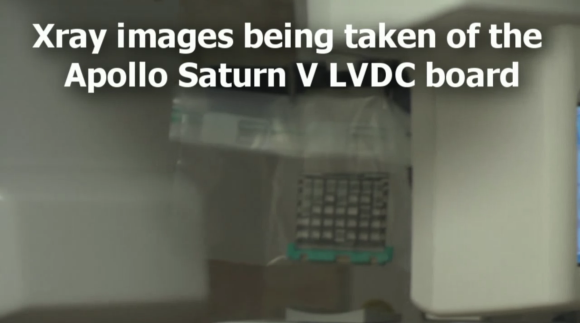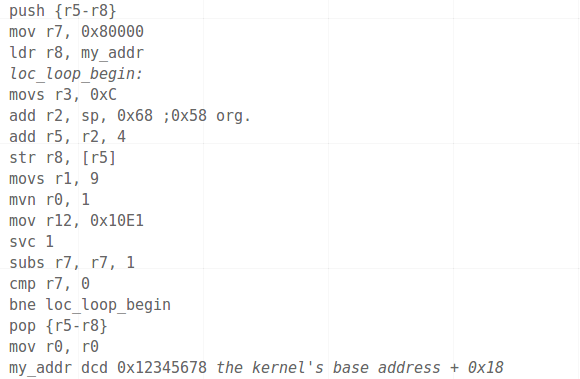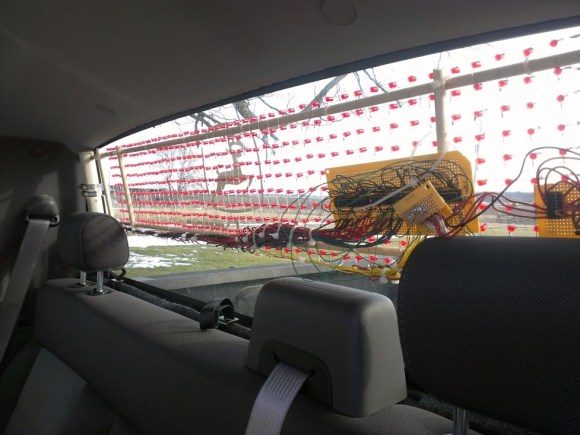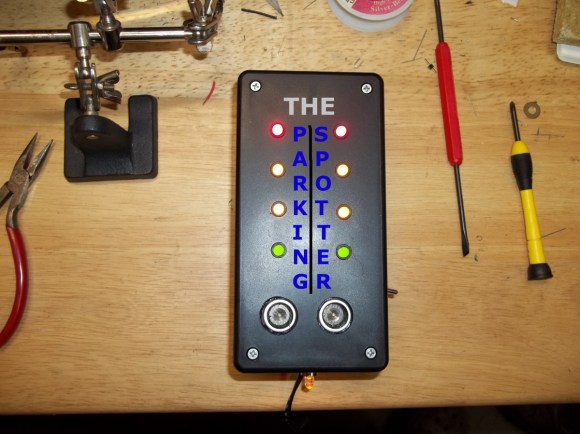In-depth look at an LVCD board from a Saturn V rocket

Join [Fran] as she dons the hat of an electronics archaeologist when looking at this vintage circuit board from the space race. As part of her personal collection she somehow acquired a Launch Vehicle Digital Computer board for a Saturn V rocket. This particular unit was never used. But it would have been had the Apollo program continued.
[Fran] is enamored with this particular board because she believes it is the forerunner of modern digital circuit design and layout. Since routing circuit boards is part of what she does for a living you can see why this is important to her. Also, who isn’t excited by actual hardware from the space program? We’ve embedded two of her videos after the break. In the first she shows off the component to the camera and speaks briefly about it. But the second video has her heading to the dentist’s office for X-rays. The image above is a rotating X-ray machine, but it looks like the best imagery comes when a handheld gun is used. They get some great images of the traces, as well as the TTL components on the board itself.
[Read more...]
Filed Under: classic hacks Tagged With: apollo, lvdc, reverse engineering, rocket, saturn v, x-ray
Unsigned code running on Windows RT

A crack has been found in the armor of Windows RT. This subset of Windows 8 is designed to run on ARM processors. The payload listed in the image above allows you to run unsigned desktop applications on the OS.
We haven’t seen very much about the Windows RT package, so it’s nice to hear [Clrokr's] thoughts on it. As far as he can tell the system has not been watered down from its Intel-aimed (x86) counterpart. Rather, RT seems to be a direct port with what is called “Code Integrity” mechanisms switched on. There is a kernel-level setting, barricaded behind UEFI’s Secure Boot, which determines the minimum software signing level allowed to run on the device. This is set to zero on a Windows 8 machine, but defaults to 8 on an ARM device. [Clrokr] uses a debugger to insert the code seen above into a DLL file in order to reset that minimum signing value to 0.
Do you have a project in mind for which this is useful? We’d love to hear about it in the comments!
[via Reddit]
Filed Under: security hacks Tagged With: arm, exploit, payload, WIndows 8, windows rt
Another take on the rear-window LED marquee

This rear-window LED marquee will help let the driver behind you know when you’re planing to change lanes or make a turn. But it also includes the ability to send a message like “Back Off!”. [Robert Dunn] was inspired to undertake the project after seeing the one we featured back in October. We’d say his has a better chance of being street legal since it uses all red LEDs.
The marquee is a matrix of 480 LEDs, all hand soldered to form the nearly transparent 48×10 grid shown above. This is important to preserve visibility out the back window of his truck. It makes us wonder about the feasibility of using SMD instead of through hole components. That would certainly make it even less visible when not illuminated, but the assembly process would be much more difficult. That’s because the 5mm LED packages fit nicely in the grid of holes he drilled in some plywood which served as the jig during soldering. The presence of leads also made the soldering process manageable.
Power to an Arduino board is provided from the cigarette lighter adapter. A set of six shift registers drive the columns while the rows are controlled by a 4017 decade counter and some transistors. Check out the blinker test video after the break to get a look at what this can do while on the road.
[Read more...]
Filed Under: led hacks, transportation hacks Tagged With: led, marquee, rear-window, sign, truck
Garage parking monitor guides you in every time

The live Adafruit Show and Tell stream from last weekend featured this project put together by [Silent Jeff]. He’s called “Silent” because when it came time to present his project on the show his microphone wasn’t working. As you can see in the video after the break, [PT] and [Ladyada] worked together to explain the project (of which they had no prior knowledge) using a game of charades. This is one of the follow-up images he sent them which details his parking spotter project.
[Ladyada] compliments [Jeff] on the finished look of the device and we agree. Not only does this do a great job of letting a driver know if they have pulled far enough into the garage, but it’s finished appearance ensures it won’t ever look out-of-place. The two silver discs near the lower end of the box are the sensors of an ultrasonic rangefinder. You mount this box so that the sensor is measuring distance between itself and the bumper of your vehicle. As the distance decreases the LEDs change to let you know when to stop. Inside the case you’ll find a voltage regulator and single-chip running the Arduino bootloader. [Jeff] says this is just his second Arduino project and we hope that at this rate we’ll be looking for big things from him in the not too distant future!
This is basically the same idea as cars that use parking assist sensors in the bumper. It’s just attached to the building instead of to the vehicle itself.
[Read more...]
Filed Under: arduino hacks, home hacks Tagged With: distance, garage, parking, rangefinder, ultrasonic
New Year’s Eve countdown clock included SMS interactivity

We remember several years back, when text messaging was first becoming popular, we went to a bar which had a huge television that would display text messages sent to a particular number. This sounds like a novelty, but in a large group of folks who know one another it’s the sandbox of social games. Wanting to tap in on that fun for his New Year’s Eve party, [James] built this countdown timer that includes an element of SMS interactivity.
The rig is projector based. A computer using Processing does the majority of the work but [James] needed a way to accepts text messages (the locale of the party had no Internet connection so this was the best bet). He grabbed a GSM shield and his Arduino Leonardo. The bulk of the evening the display showed the last few messages received, with a small countdown timer in the lower corner. As the countdown approached zero the time was given prominence as in the image above. We guess he was lucky to find a prepaid SIM card that allowed free incoming text messages. Our cell provider charges us 20¢ for each.
You might give this one a whirl next year. If it’s not quite your thing take a look around. We’ve seen a lot of fun setups like this mini ball drop.
Filed Under: arduino hacks, Holiday Hacks Tagged With: countdown timer, gsm, sms, text message
Glass delay line slide used in an RGB lamp

The spire used in this lamp is a part from an old television. It’s a glass delay line slide which pipes the light up from the Bluetooth controlled RGB lamp (translated) in the base.
We have looked at delay lines previously when [Dave Jones] tore down a camcorder to get at one. But we must have missed the EEVblog follow-up episode which explains how the glass slides work. The device uses physical distance to form a delay. Waves directed into the edge of the glass slide bounce around at an angle before being sensed at the collection point. [Lukas] liked the visual appearance of the part and decided to use it to add visual interest to his lamp project. The nature of the glass makes it perfect for directing the light up and away from the PCB.
The lamp consists of one RGB LED module controlled by an ATtiny2313 microcontroller. Also on board is a HC-05 Bluetooth module. This along with an app he wrote lets the user change lamp color and behavior wirelessly. You can see the lamp in action in the video after the break, but we think the camera shot probably doesn’t do it the justice it deserves.
[Read more...]
Filed Under: led hacks Tagged With: attiny2313, bluetooth, delay line memory, glass delay line, hc-05, lamp, led, light pipe, rgb
LED ice cubes prevent alcohol induced blackouts

On November 23rd last year, [Dhairya] attended a little shindig at MIT. Three drinks into the night, he blacked out and woke up in the hospital the next day. It was an alcohol-induced blackout, and like all parties at MIT, there’s an ingenious solution to [Dhairya]‘s problem.
[Dhairya] came up with an alcohol-aware ice cube made of a coin cell battery, an ATtiny microcontroller, and an IR transceiver are molded into an edible gelatin ice cube. The microcontroller counts the number of sips per drink, and after one glass of adult beverage changes the color of the flashing LED from green to yellow. After two drinks the LED changes from yellow to red, signaling [Dhairya] to slow down.
If [Dhairya] feels the night is too young and keeps on drinking, the IR transmitter signals to his cell phone to send a text to a friend telling them to go take [Dhairya] home.
Less than three weeks after waking up in the hospital, [Dhairya] tested out his glowing ice cubes at another party. Everything performed wonderfully, even if he admits his creation is a little crude. A neat piece of work, and we can’t wait to see an update to this project.
[Read more...]

